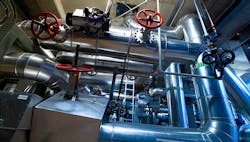How to effectively purge pipes at your facility
An important commissioning activity prior to startup is line cleaning to remove debris. Loose material, which can include scale, sand, rust, dirt, plastic or fibers, can wind up blocking downstream equipment, plugging tower packings and valves, fouling heat exchangers, etc. The surest way to minimize loose debris in equipment is via careful cleaning and inspection before closing the equipment. The most-effective way to deal with pipes or ducts is to use a pig to physically push out the debris.
However pigging frequently isn’t practical for large pipe networks or when time is short. An alternative often used is to purge with a flush fluid or air. While a purge can’t remove every item, it can eliminate items that likely would come loose in normal operation.
The purge fluid imposes a drag force on material left in the pipe. If the drag force is high enough, the material moves to a collection point, e.g., a strainer or a trash container by an open pipe end.
To learn more, read "Fluid Handling: Effectively Purge Lines" from Chemical Processing.
